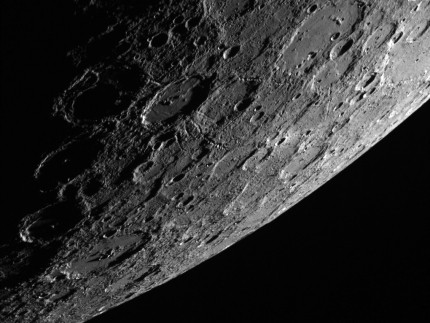Mercury's Mysterious Darkened Surface: It's All About 'Invisible Paint' of Comet Dust
| Ana Verayo | | Mar 31, 2015 02:13 AM EDT |
(Photo : NASA/Johns Hopkins University Applied Physics Laboratory/Carnegie Institution of Washington) This image from the Wide Angle Camera aboard NASA's MESSENGER spacecraft shows Mercury's mysteriously dark surface.
A new study reveals that Mercury, the planet closest to the sun, is apparently covered by a thin layer of black dust from billions of years of deposits accumulated from passing comets.
This comet dust is made from carbon rich materials and acts like an "invisible paint" that lowers the reflective properties of the tiny planet. Comet dust is made of 25 percent carbon.
Like Us on Facebook
Planets that don't have an atmosphere like our moon experience regular impacts from micrometeorites. Since these worlds are airless, this process generates a thin layer of tiny particles of nanophase iron that can darken surfaces.
Spectral analysis has proven these material concentrations on Mercury aren't high enough to produce this type of thin layer of "invisible paint".
Mercury's low reflectance can be attributed to some mysterious darkening agent, according to Megan Bruck Syal of the Lawrence Livermore National Laboratory. This is the first time scientists consider material from passing comets dumped on Mercury.
Comets are essentially frozen bodies that break-up when they approach the Sun. There is a high chance Mercury would be exposed to comet dust during the course of billions of years from comets and other passing bodies.
Syal estimates Mercury is now made of three to six percent of carbon, originating from comets and micrometeorites.
To prove their theory about this mystery thin layer, scientists used the Ames Vertical Gun Range to run experiments on how these impacts and the scattering of this material darkened the surface of Mercury. Here, a 14-foot cannon fires projectiles at speeds of up to 16,000 miles per hour.
NASA uses this facility for small scale simulations of high speed celestial body impacts. This gun helps with scenarios that can happen to entry vehicles, asteroid impacts on planets and micrometeoroid impacts on spacecraft.
After conducting the projectile impact experiments, researchers found this process reduced reflectivity by five percent, which is similar to the darkest regions of Mercury. Spectroscopic analysis revealed this coating was undetectable in the dark coating, which suggests the material found in Mercury acts like an invisible paint.
This study ws published in the journal, Nature Geoscience.
TagsMercury's Mysterious Darkened Surface: It's All About 'Invisible Paint' of Comet Dust, mercury planet, mercury invisible paint, mercury comet dust
©2015 Chinatopix All rights reserved. Do not reproduce without permission
EDITOR'S PICKS
-

Did the Trump administration just announce plans for a trade war with ‘hostile’ China and Russia?
-

US Senate passes Taiwan travel bill slammed by China
-

As Yan Sihong’s family grieves, here are other Chinese students who went missing abroad. Some have never been found
-

Beijing blasts Western critics who ‘smear China’ with the term sharp power
-

China Envoy Seeks to Defuse Tensions With U.S. as a Trade War Brews
-

Singapore's Deputy PM Provides Bitcoin Vote of Confidence Amid China's Blanket Bans
-

China warns investors over risks in overseas virtual currency trading
-

Chinese government most trustworthy: survey
-

Kashima Antlers On Course For Back-To-Back Titles
MOST POPULAR
LATEST NEWS
Zhou Yongkang: China's Former Security Chief Sentenced to Life in Prison

China's former Chief of the Ministry of Public Security, Zhou Yongkang, has been given a life sentence after he was found guilty of abusing his office, bribery and deliberately ... Full Article
TRENDING STORY

China Pork Prices Expected to Stabilize As The Supplies Recover

Elephone P9000 Smartphone is now on Sale on Amazon India

There's a Big Chance Cliffhangers Won't Still Be Resolved When Grey's Anatomy Season 13 Returns

Supreme Court Ruled on Samsung vs Apple Dispute for Patent Infringement

Microsoft Surface Pro 5 Rumors and Release Date: What is the Latest?










